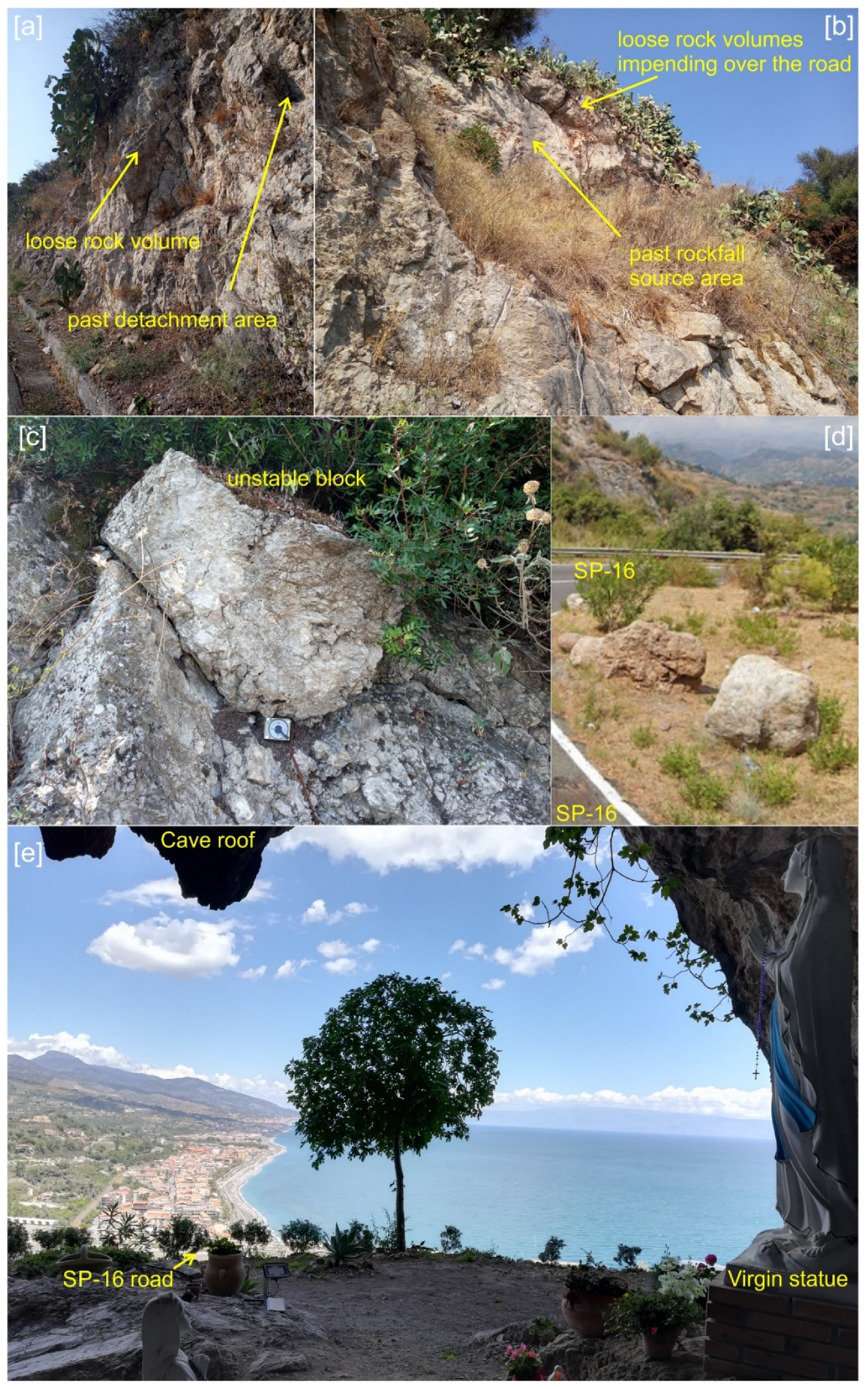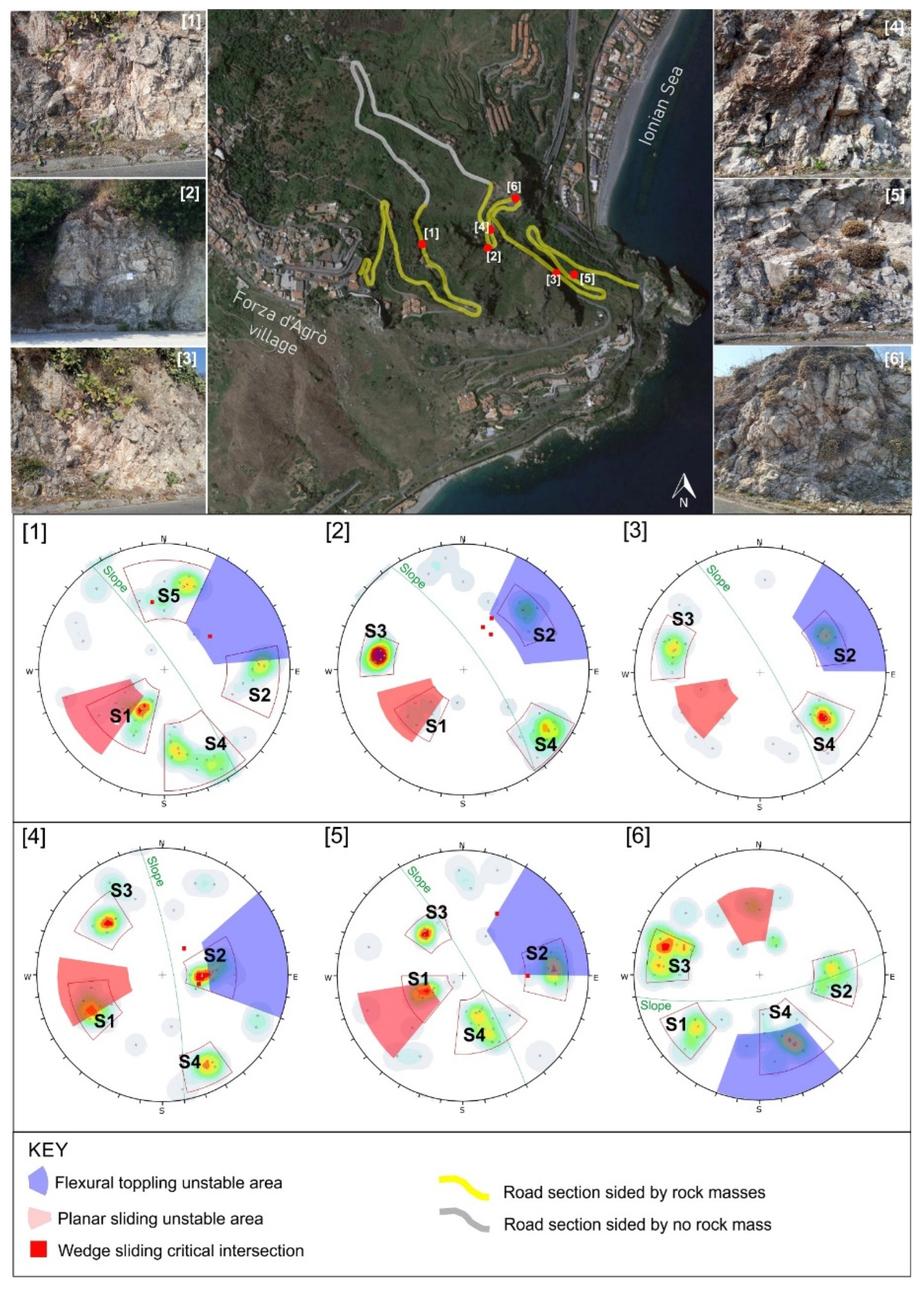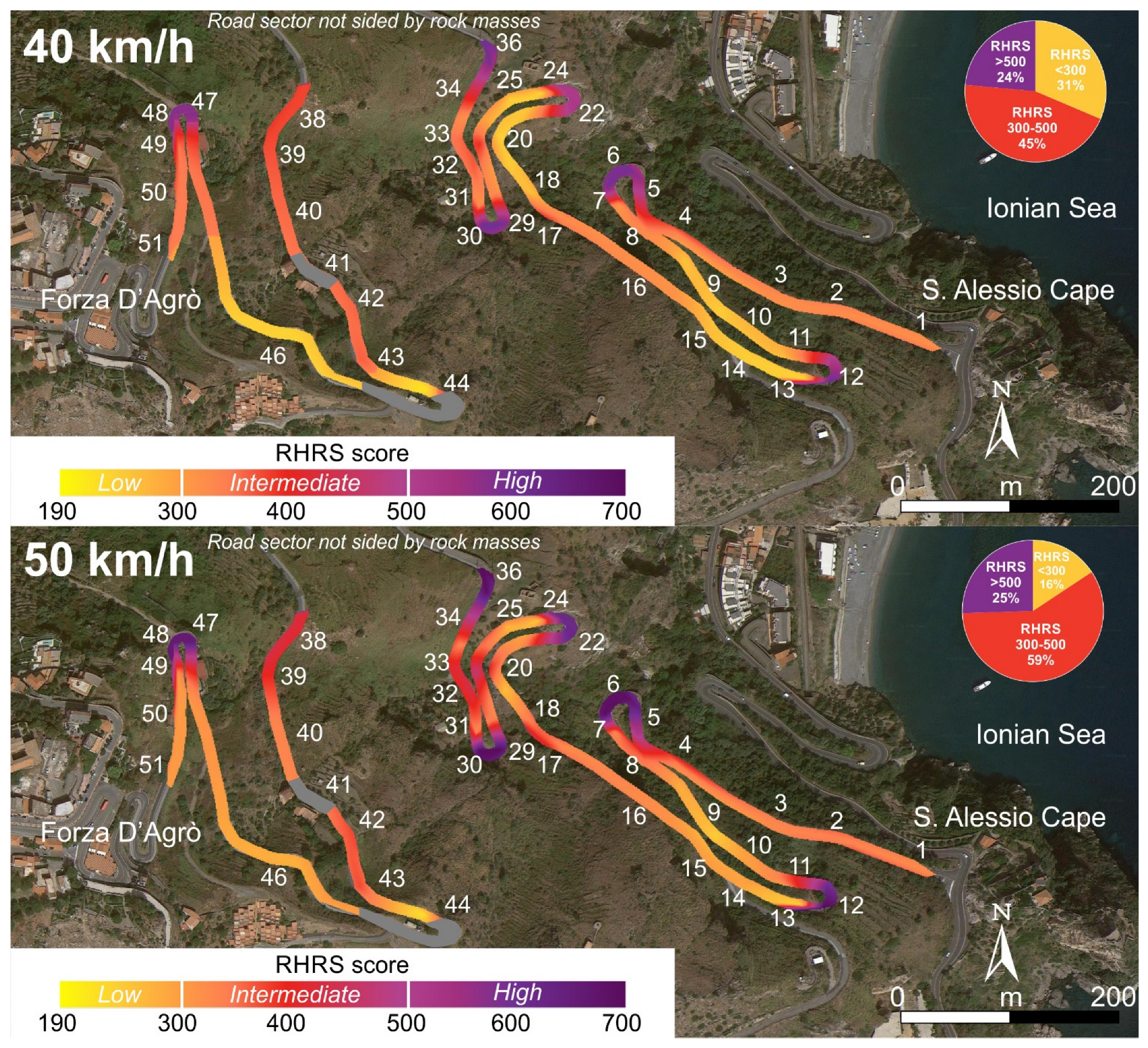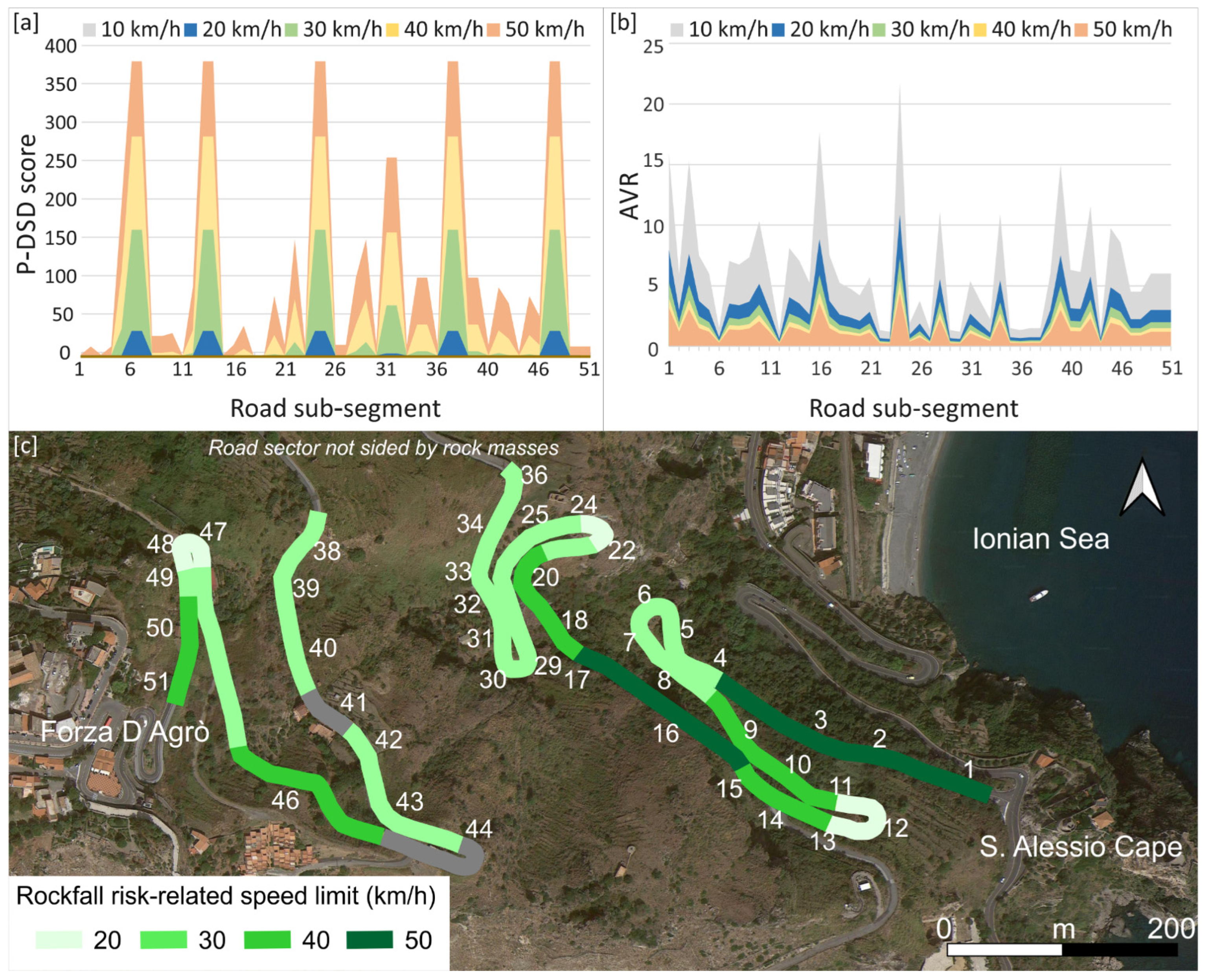Interaction between Rockfalls and Vehicles Studied for Speed Limit Zonation along Mountainous Roads
Abstract
:1. Introduction
2. The Study Area
3. Materials and Methods
- -
- High: RHRS scores >500 suggest that the studied road segment has to be considered to have “immediate need of stabilization measures”;
- -
- Intermediate: 300 < RHRS < 500 suggests that the studied road segment has a “high priority of remedial work”, although a case-by-case evaluation would be appropriate [8].
- -
- Low: RHRS scores < 300 are an index of “low urgency” in designing mitigation measures [14].
4. Results
4.1. Rock Mass Survey and Kinematic Analysis
4.2. Rockfall Risk Zonation
5. Discussion
6. Conclusions
Author Contributions
Funding
Conflicts of Interest
References
- Guzzetti, F.; Stark, C.P.; Salvati, P. Evaluation of Flood and Landslide Risk to the Population of Italy. Environ. Manag. 2005, 36, 15–36. [Google Scholar] [CrossRef] [PubMed]
- Bunce, C.M.; Cruden, D.M.; Morgenstern, N.R. Assessment of the hazard from rock fall on a highway. Can. Geotech. J. 1997, 34, 344–356. [Google Scholar] [CrossRef]
- Mignelli, C.; Lo Russo, S.; Peila, D. ROckfall Risk MAnagement Assessment: The RO.MA. Approach. Nat. Hazards 2012, 62, 1109–1123. [Google Scholar] [CrossRef]
- Mineo, S.; Pappalardo, G.; Rapisarda, F.; Cubito, A.; Di Maria, G. Integrated Geostructural, Seismic and Infrared Thermography Surveys for the Study of an Unstable Rock Slope in the Peloritani Chain (NE Sicily). Eng. Geol. 2015, 195, 225–235. [Google Scholar] [CrossRef]
- Othman, A.; Shaaban, F.; Abotalib, A.Z.; El-Saoud, W.A.; Gabr, S.S.; Habeebullah, T.; Hegazy, D. Hazard Assessment of Rockfalls in Mountainous Urban Areas, Western Saudi Arabia. Arab. J. Sci. Eng. 2021, 46, 5717–5731. [Google Scholar] [CrossRef]
- Pappalardo, G.; Mineo, S.; Rapisarda, F. Rockfall Hazard Assessment along a Road on the Peloritani Mountains (Northeastern Sicily, Italy). Nat. Hazards Earth Syst. Sci. 2014, 14, 2735–2748. [Google Scholar] [CrossRef] [Green Version]
- Mineo, S.; Pappalardo, G.; D’Urso, A.; Calcaterra, D. Event Tree Analysis for Rockfall Risk Assessment along a Strategic Mountainous Transportation Route. Environ. Earth Sci. 2017, 76, 620. [Google Scholar] [CrossRef] [Green Version]
- Budetta, P. Assessment of Rockfall Risk along Roads. Nat. Hazards Earth Syst. Sci. 2004, 4, 71–81. [Google Scholar] [CrossRef] [Green Version]
- Mignelli, C.; Peila, D.; Lo Russo, S.; Ratto, S.M.; Broccolato, M. Analysis of Rockfall Risk on Mountainside Roads: Evaluation of the Effect of Protection Devices. Nat. Hazards 2014, 73, 23–35. [Google Scholar] [CrossRef]
- Macciotta, R.; Martin, C.D.; Morgenstern, N.R.; Cruden, D.M. Quantitative Risk Assessment of Slope Hazards along a Section of Railway in the Canadian Cordillera—A Methodology Considering the Uncertainty in the Results. Landslides 2016, 13, 115–127. [Google Scholar] [CrossRef]
- Pappalardo, G.; Mineo, S. Rockfall Hazard and Risk Assessment: The Promontory of the Pre-Hellenic Village Castelmola Case, North-Eastern Sicily (Italy). In Engineering Geology for Society and Territory; Lollino, G., Giordan, D., Crosta, G.B., Corominas, J., Azzam, R., Wasowski, J., Sciarra, N., Eds.; Springer International Publishing: Cham, Switzerland, 2015; Volume 2, pp. 1989–1993. [Google Scholar] [CrossRef]
- UNESCO. Risk Management Training Handbook; BSP-2010/WS7; UNESCO: Paris, France, 2010. [Google Scholar]
- Ball, D.; Watt, J. Risk management and cultural presentation. In Proceedings of the ARIADNE Workshop 4, Vulnerability of Cultural Heritage to Hazards and Prevention Measures, Prague, Czech Republic, 18–24 August 2001. [Google Scholar]
- Pierson, L.A.; Davis, S.A.; Van Vickle, R. Rockfall Hazard Rating System—Implementation Manual, Federal Highway Administration (FHWA); Report FHWAOR-EG-90-01, FHWA; US Department of Transportation: Washington, DC, USA, 1990.
- Pantelidis, L. A Critical Review of Highway Slope Instability Risk Assessment Systems. Bull. Eng. Geol. Environ. 2011, 70, 395–400. [Google Scholar] [CrossRef]
- Ferrari, F.; Giacomini, A.; Thoeni, K. Qualitative Rockfall Hazard Assessment: A Comprehensive Review of Current Practices. Rock Mech. Rock Eng. 2016, 49, 2865–2922. [Google Scholar] [CrossRef]
- Budetta, P.; Nappi, M. Comparison between Qualitative and Quantitative Rockfall Risk Methods for a Hazardous Road Stretch. In Proceedings of the 4th International Conference on Energy Systems, Environment, Entrepreneurship and Innovation (ICESEEI ‘15)-Proceedings of the 4th International Conference on Agricultural Science, Biotechnology, Food and Animal Science (ABIFA ‘15), Dubai, United Arab Emirates, 22–24 February 2015; Mastorakis, N.E., Ed.; pp. 13–17, ISBN 978-1-61804-270-5. [Google Scholar]
- Mineo, S. Comparing Rockfall Hazard and Risk Assessment Procedures along Roads for Different Planning Purposes. J. Mountain Sci. 2020, 17, 653–669. [Google Scholar] [CrossRef]
- Damjanović, M.; Stević, Z.; Stanimirović, D.; Tanackov, I.; Marinković, D. Impact of the Number of Vehicles on Traffic Safety: Multiphase Modeling. Facta Univ. Ser. Mech. Eng. 2022, 20, 177–197. [Google Scholar]
- Sándor, Z. Possible Traffic Safety Effects of the Implementation of Section Control in Hungary. Acta Tech. Jaurinensis 2020, 13, 309–323. [Google Scholar] [CrossRef]
- Peila, D.; Guardini, C. Use of the Event Tree to Assess the Risk Reduction Obtained from Rockfall Protection Devices. Nat. Hazards Earth Syst. Sci. 2008, 8, 1441–1450. [Google Scholar] [CrossRef] [Green Version]
- Maerz, N.H. New Risk-Consequence Rockfall Hazard Rating System for Missouri Highways Using Digital Image Analysis. Environ. Eng. Geosci. 2005, 11, 229–249. [Google Scholar] [CrossRef]
- Youssef, A.M.; Maerz, N.H. Development, Justification, and Verification of a Rock Fall Hazard Rating System. Bull. Eng. Geol. Environ. 2012, 71, 171–186. [Google Scholar] [CrossRef]
- Vandewater, C.J. Classifying and Assessing the Geologic Contribution to Rockfall Hazard. Environ. Eng. Geosci. 2005, 11, 141–154. [Google Scholar] [CrossRef]
- Santi, P.M.; Russell, C.P.; Higgins, J.D.; Spriet, J.I. Modification and Statistical Analysis of the Colorado Rockfall Hazard Rating System. Eng. Geol. 2009, 104, 55–65. [Google Scholar] [CrossRef]
- Aqeel, A.M. Rockfall Hazard Rating System(s) in Saudi Arabia—A Review. J. Geogr. Geol. 2018, 10, 1. [Google Scholar] [CrossRef] [Green Version]
- Maerz, N.H.; Youssef, A.M.; Pradhan, B.; Bulkhi, A. Remediation and Mitigation Strategies for Rock Fall Hazards along the Highways of Fayfa Mountain, Jazan Region, Kingdom of Saudi Arabia. Arab. J. Geosci. 2015, 8, 2633–2651. [Google Scholar] [CrossRef]
- Molk, M.; Poisel, R.; Weilbold, J.; Angerer, H. Rockfall Rating Systems: Is There a Comprehensive Method for Hazard Zoning in Populated Areas? In Proceedings of the 11th Congress INTERPRAEVENT 2008: Conference Proceedings, Dornbirn, Austria, 26–30 May 2008; pp. 2017–2018. [Google Scholar]
- Saroglou, H.; Marinos, V.; Marinos, P.; Tsiambaos, G. Rockfall Hazard and Risk Assessment: An Example from a High Promontory at the Historical Site of Monemvasia, Greece. Nat. Hazards Earth Syst. Sci. 2012, 12, 1823–1836. [Google Scholar] [CrossRef] [Green Version]
- Cirrincione, R.; Fazio, E.; Ortolano, G.; Pezzino, A.; Punturo, R. Fault-Related Rocks: Deciphering the Structural–Metamorphic Evolution of an Accretionary Wedge in a Collisional Belt, NE Sicily. Int. Geol. Rev. 2012, 54, 940–956. [Google Scholar] [CrossRef]
- Barreca, G.; Scarfì, L.; Gross, F.; Monaco, C.; De Guidi, G. Fault Pattern and Seismotectonic Potential at the South-Western Edge of the Ionian Subduction System (Southern Italy): New Field and Geophysical Constraints. Tectonophysics 2019, 761, 31–45. [Google Scholar] [CrossRef]
- Song, D.; Liu, X.; Li, B.; Zhang, J.; Bastos, J.J.V. Assessing the Influence of a Rapid Water Drawdown on the Seismic Response Characteristics of a Reservoir Rock Slope Using Time–Frequency Analysis. Acta Geotech. 2021, 16, 1281–1302. [Google Scholar] [CrossRef]
- Song, D.; Liu, X.; Chen, Z.; Chen, J.; Cai, J. Influence of Tunnel Excavation on the Stability of a Bedded Rock Slope: A Case Study on the Mountainous Area in Southern Anhui, China. KSCE J. Civ. Eng. 2021, 25, 114–123. [Google Scholar] [CrossRef]
- Mineo, S.; Pappalardo, G.; Onorato, S. Geomechanical Characterization of a Rock Cliff Hosting a Cultural Heritage through Ground and UAV Rock Mass Surveys for Its Sustainable Fruition. Sustainability 2021, 13, 924. [Google Scholar] [CrossRef]
- Mineo, S.; Caliò, D.; Pappalardo, G. UAV-Based Photogrammetry and Infrared Thermography Applied to Rock Mass Survey for Geomechanical Purposes. Remote Sens. 2022, 14, 473. [Google Scholar] [CrossRef]
- Ulusay, R. ; International Society for Rock Mechanics (Eds.) The Complete ISRM Suggested Methods for Rock Characterization, Testing and Monitoring: 1974–2006; Commission on Testing Methods, International Society for Rock Mechanics: Ankara, Turkey, 2007. [Google Scholar]
- Romana, M. New Adjustment Ratings for Application of Bieniawski Classification to Slopes. In Proceedings of the International Symposium on the Role of Rock Mechanics, International Society for Rock Mechanics, Salzburg, Austria, 2–4 September 1985; pp. 49–53. [Google Scholar]
- Bieniawski, Z.T. Engineering Rock Mass Classifications: A Complete Manual for Engineers and Geologists in Mining, Civil, and Petroleum Engineering; Wiley: New York, NY, USA, 1989. [Google Scholar]







| Category | Rating Criteria by Score | |||
|---|---|---|---|---|
| Points 3 | Points 9 | Points 27 | Points 81 | |
| Slope height | 7.5 m | 15 m | 22.5 m | >30 m |
| Ditch effectiveness | Good catchment: properly designed according to updates of Ritchie’s design chart + barriers | Moderate catchment: properly designed according to updates of Ritchie’s design chart | Limited catchment: wrongly designed | No catchment |
| AVR (% of time) | 25% | 50% | 75% | 100% |
| P-DSD | Adequate (100%) | Moderate (80%) | Limited (60%) | Very limited (40%) |
| Roadway width | 21.5 m | 15.50 m | 9.50 m | 3.50 m |
| SMR | 80 | 40 | 27 | 20 |
| Block size Boulder volume | 30 cm 26 dm3 | 60 cm 0.21 m3 | 90 cm 0.73 m3 | 120 cm 1.74 m3 |
| Volume of rockfall per event | 2.3 m3 | 4.6 m3 | 6.9 m3 | 9.2 m3 |
| Annual rainfall and freezing periods | h = 300 mm or no freezing period | h = 600 mm or short freezing period | h = 900 mm or long freezing period | h = 1200 mm or long freezing period |
| Rockfall frequency | 1 per 10 years | 3 per year | 6 per year | 9 per year |
| Station | RMRb | Bieniawski Class [38] | c’ (kPa) | Φ (°) | SMR | Romana Class [37] |
|---|---|---|---|---|---|---|
| S1 | 50 | III Fair rock | 250 | 30 | 53 | III Fair |
| S2 | 53 | III Fair rock | 265 | 31 | 55 | III Fair |
| S3 | 51 | III Fair rock | 256 | 30 | 52 | III Fair |
| S4 | 54 | III Fair rock | 274 | 32 | 51 | III Fair |
| S5 | 55 | III Fair rock | 277 | 32 | 52 | III Fair |
| S6 | 48 | III Fair rock | 243 | 29 | 50 | III Fair |
| Station | Planar Sliding | Wedge Sliding | Flexural Toppling |
|---|---|---|---|
| Kinematically unstable sets | |||
| S1 | S1/RD | S1–S4/S1–S2 | S2 |
| S2 | S1 | S1–S4/S4–S3/S1–S3 | S2 |
| S3 | RD | / | S2 |
| S4 | S1 | S1–S4/S3–S1 | S2 |
| S5 | S1/RD | S1–S3/S1–S4 | S2 |
| S6 | RD | / | S4/RD |
Publisher’s Note: MDPI stays neutral with regard to jurisdictional claims in published maps and institutional affiliations. |
© 2022 by the authors. Licensee MDPI, Basel, Switzerland. This article is an open access article distributed under the terms and conditions of the Creative Commons Attribution (CC BY) license (https://creativecommons.org/licenses/by/4.0/).
Share and Cite
Pappalardo, G.; Caliò, D.; Mineo, S. Interaction between Rockfalls and Vehicles Studied for Speed Limit Zonation along Mountainous Roads. Appl. Sci. 2022, 12, 4096. https://doi.org/10.3390/app12094096
Pappalardo G, Caliò D, Mineo S. Interaction between Rockfalls and Vehicles Studied for Speed Limit Zonation along Mountainous Roads. Applied Sciences. 2022; 12(9):4096. https://doi.org/10.3390/app12094096
Chicago/Turabian StylePappalardo, Giovanna, Davide Caliò, and Simone Mineo. 2022. "Interaction between Rockfalls and Vehicles Studied for Speed Limit Zonation along Mountainous Roads" Applied Sciences 12, no. 9: 4096. https://doi.org/10.3390/app12094096






